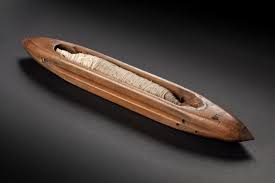Flying Shuttle

The flying shuttle was a game-changing invention in the world of weaving. Imagine a time in the 18th century when weaving was a labor-intensive, slow, and meticulous process. Weavers had to pass a shuttle loaded with weft thread (the thread running horizontally) through the warp threads (the threads running vertically) by hand, meticulously and patiently. But then, enter John Kay, an ingenious inventor from England, who revolutionized this centuries-old craft.
In 1733, John Kay introduced the world to the "flying shuttle." Picture this: it's a simple yet brilliant device, operated deftly by the weaver's hands and feet. This innovative contraption allowed the shuttle to dart back and forth across the loom with remarkable speed and efficiency, changing the face of weaving forever.
With the flying shuttle, weavers could weave fabric faster than ever before. It wasn't just about speed; the flying shuttle also made it possible to weave wider fabrics, a significant development as the demand for broader textiles grew. Plus, it reduced the need for two weavers working in tandem, cutting down on labor costs and making weaving more economically viable.
However, like all inventions, it had its challenges. The increased weaving speed meant that more thread was required, pushing the envelope for innovations in spinning technology to keep up. Tension issues with the warp threads sometimes arose due to the flying shuttle's rapid back-and-forth motion.
The flying shuttle marked the dawn of weaving mechanization, setting the stage for further advancements in textile machinery. It played a pivotal role in the Industrial Revolution, reshaping the textile industry and manufacturing as a whole.
So, in the annals of history, the flying shuttle stands as a testament to human ingenuity, transforming a once painstaking craft into a mechanized industry that would change the world.
